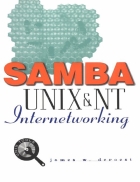




Mã tài liệu: 202130
Số trang: 223
Định dạng: pdf
Dung lượng file:
Chuyên mục: Khoa học công nghệ
Samba: UNIX and Windows Internetworking is a text describing how Samba can be used to unify and integrate network based file and print resources in a heterogeneous desktop and server computing environment. Along with a general discussion of how to install, configure and manage Samba, the text will also address how Samba can be used to resolve mobile computing synchronization problems, integrate authentication and access controls in small to large enterprises and interoperate with Windows 2000. Samba is an Open Source software suite of UNIX services that enable MS Windows and other desktop clients to access UNIX file systems and printers via Microsoft's Server Message Block (SMB) and Common Internet File System (CIFS) protocols. Since its inception in 1991, Samba has continued to evolve and incorporate new features. The latest versions of Samba offer much of the functionality provided by the Windows NT Domain system. Originally used primarily within academia and research institutions, Samba has grown in popularity and is now supported by over 100 commercial vendors worldwide. Samba is readily available, including source code, for most UNIX platforms under the GNU General Public Licensing agreement. A sampling of supported clients include DOS, Windows for Workgroups 3.11, Windows 95/98, Windows NT OS/2, Macintosh, VMS, and MVS.
The target audience for this work includes systems programmers and administrators who are looking for assistance in implementing Samba in new and existing Windows and UNIX environments. A basic overview of both UNIX and Windows system and network architectures is provided to assist those readers whose primary background may be in one or the other of these operating environments. The general narrative of the text focuses on how to install and configure Samba to facilitate various authentication models favoring either UNIX or Windows as a primary security authority. This includes how Samba can be configured to act as an NT Primary Domain Controller and how Samba coexists with Windows 2000. The subject matter is partitioned by function to facilitate quick access to topics of interest. Advanced topics are integrated into each of the functional chapters to reduce having to move back and forth between general and advanced chapters. Sections on operation and client tools will benefit end users who want a better understanding of how to tailor and optimize their use of Samba services.
Những tài liệu gần giống với tài liệu bạn đang xem
📎 Số trang: 256
👁 Lượt xem: 405
⬇ Lượt tải: 16
Những tài liệu bạn đã xem
 Samba UNIX and NT Internetworking
Samba: UNIX and Windows Internetworking is a text describing how Samba can be used to unify and integrate network based file and print resources in a heterogeneous desktop and server computing environment. Along with a general discussion of how to
pdf Đăng bởi
googme
Samba UNIX and NT Internetworking
Samba: UNIX and Windows Internetworking is a text describing how Samba can be used to unify and integrate network based file and print resources in a heterogeneous desktop and server computing environment. Along with a general discussion of how to
pdf Đăng bởi
googme